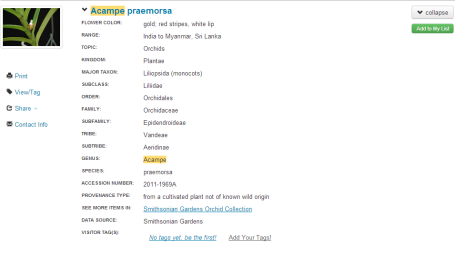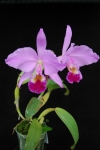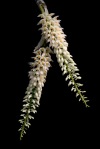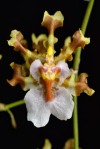Posts tagged ‘SIRIS’
Explore Smithsonian Gardens’ Orchids Online!
At the end of April, after ten months of planning, coordinating, and troubleshooting, the Smithsonian Gardens Orchid Collection (SGOC) went live. No, we didn’t kill off all of the plants over the winter and revive them for this announcement . . . I mean live as in on-air, online, and freely accessible! SGOC is now available for the world to explore on the Smithsonian Collections Search Center and is the only living collection to join the multitudes of objects, specimens, and archival records that are contained within the site. Below is a snapshot of what an individual catalog record looks like:

Example of a Smithsonian Gardens Orchid Collection record in the Smithsonian Institution Collections Search Center.
Records are updated twice a month and contain basic information about each accession, such as scientific name, flower color, range (if a species), and taxonomy. One of the best parts of having the collection online is being able to peruse the beautiful images taken by our talented volunteers Gene Cross, Bryan Ramsay, and James Osen. So far, about a third of the records have images associated with them. We only photograph the orchids when they are in bloom, but many of our orchids (especially the species) are either too small to bloom, or haven’t yet bloomed during their time at the greenhouses.
- Cattleya labiata ‘1542-Dark’ x self. Smithsonian Gardens Orchid Collection, photo by Eugene Cross.
- Dendrobium secundum var. album. Smithsonian Gardens Orchid Collection, photo by James Osen.
- Cyrtochilum maduroi. Smithsonian Gardens Orchid Collection, photo by Bryan Ramsay.
SGOC’s presence on the Collections Search Center is serving as motivation to improve Smithsonian Gardens’ collection records in BG-BASE and correct plant identification errors. Our hope is that these records can be a valuable resource for educators, students, researchers, and curious individuals, and a source of orchid inspiration year-round.
-Julie Rotramel, Smithsonian Gardens Living Collections Contractor
The Doctor Is In: Physic Gardens

University of Cincinnati Medicinal Herb Garden, 1977. Elise H. Warrington, photographer.
While gardens have long been used for medicinal and culinary purposes, the first documented physic garden, and perhaps the most widely known, was the Chelsea Physic Garden in London, founded in 1673. Physic gardens were closely related to botanical gardens, as both garden types encouraged the collection, documentation and study of different plant species as well as promoting horticultural education to the public. The primary difference between the two garden types was that physic gardens were principally concerned with growing herbs for their medicinal qualities; the Chelsea Garden began as an apothecary’s garden used to train apprentices in identifying plants. Today the garden still exists and has a major role in public education, with a focus on natural medicine.

Sheffield Garden, 2000. Emilie Lapham, photographer.
Physic gardens can be credited with influencing not only botanical gardens, but also the modern herb garden. The Archives of American Gardens Garden Club of America Collection includes many examples of both public and private herb gardens. Exemplifying the contemporary role of herb gardens in education, the University of Cincinnati’s College of Medicine hosts an herb garden, with a variety of medicinal plants (including marigolds and aloe) lining the college’s walkways. Compared to the University of Cincinatti, the herb garden within the private Sheffield Garden of Wyndmoor, Pennsylvania appears much more whimsical. Accompanied by statuary and a flowering border, it demonstrates how the herb garden can be valued both for its aesthetic and utilitarian appeal.
Jessica Dame, Archive of American Gardens, Garden Club of America History and Design Intern




